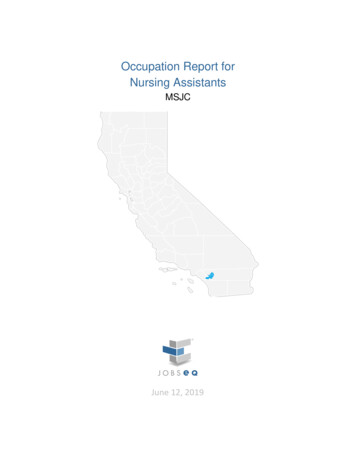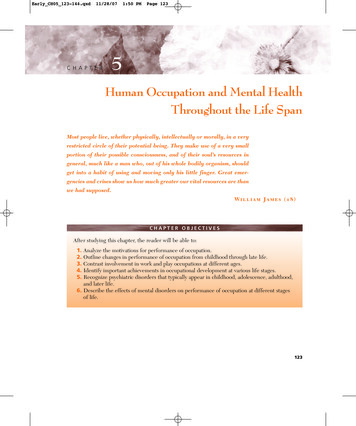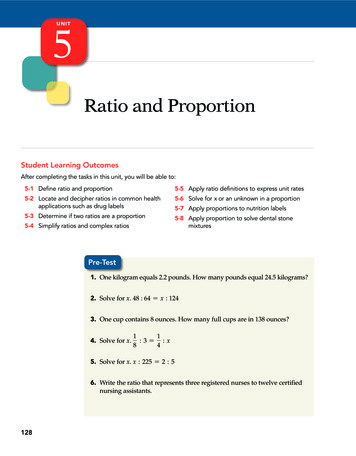
Transcription
Occupation Report forNursing AssistantsMSJCJune 12, 2019
DEFINITION OF NURSING ASSISTANTS, SOC 31-1014 . 3OCCUPATION SNAPSHOT . 4GEOGRAPHIC DISTRIBUTION . 5EMPLOYMENT BY INDUSTRY . 7WAGES . 9EDUCATION PROFILE . 10AWARDS . 11APPRENTICESHIPS . 12REGION DEFINITION . 13FAQ . 14Source: JobsEQ , http://www.chmuraecon.com/jobseqCopyright 2019 Chmura Economics & Analytics, All Rights Reserved.2
Definition of Nursing Assistants, SOC 31-1014Provide basic patient care under direction of nursing staff. Perform duties such as feed, bathe, dress, groom, ormove patients, or change linens. May transfer or transport patients. Includes nursing care attendants, nursing aides,and nursing attendants. Excludes “Home Health Aides” (31-1011), “Orderlies” (31-1015), “Personal Care Aides” (399021), and “Psychiatric Aides” (31-1013).Source: JobsEQ , http://www.chmuraecon.com/jobseqCopyright 2019 Chmura Economics & Analytics, All Rights Reserved.3
Occupation SnapshotAs of 2019Q1, total employment for Nursing Assistants in the MSJC was 770. Over the past three years, thisoccupation added 63 jobs in the region and is expected to increase by 111 jobs over the next seven years, or at anannual average rate of 1.9%.Occupation Snapshot of Nursing Assistants in MSJC, 2019q1CurrentFour Quarters Ending with 2019q13-Year History-----2019q1-----TotalChangeAvg Ann %Chg in Empl7-Year Forecast--Separations-----Growth---EmplAvg AnnWages1LQUnemplUnemplRateOnline JobAds2EmplRegionTotal NewDemandExitsTransfersEmplAvg AnnRate770 32,9000.71463.6%28632.9%7713603011111.9%Source: JobsEQ Data as of 2019Q1 unless noted otherwiseNote: Figures may not sum due to rounding.1. Occupation wages are as of 2017 and should be taken as the average for all Covered Employment2. Data represent found online ads active within the last thirty days in the selected region; data represents a sampling rather than the complete universe of postings. Ads lacking zip codeinformation but designating a place (city, town, etc.) may be assigned to the zip code with greatest employment in that place for queries in this analytic. Due to alternative county-assignmentalgorithms, ad counts in this analytic may not match that shown in RTI (nor in the popup window ad list).Occupation employment data are estimated via industry employment data and the industry/occupation mix. Industry employment data are derived from the Quarterly Census of Employment andWages, provided by the Bureau of Labor Statistics and currently updated through 2018Q3, imputed where necessary with preliminary estimates updated to 2019Q1. Wages by occupation are asof 2017 provided by the BLS and imputed where necessary. Forecast employment growth uses national projections from the Bureau of Labor Statistics adapted for regional growth patterns.Occupation unemployment figures are imputed by Chmura.Source: JobsEQ , http://www.chmuraecon.com/jobseqCopyright 2019 Chmura Economics & Analytics, All Rights Reserved.4
Geographic DistributionThe below maps illustrate the ZCTA-level distribution of employed Nursing Assistants in the MSJC. Employment isshown by place of work and by residence.Top ZCTAs by Place of Work for Nursing Assistants, 2019Q1RegionEmploymentZCTA 92562183ZCTA 92543147ZCTA 92545126ZCTA 9258690ZCTA 9259552ZCTA 9256352ZCTA 9259141ZCTA 9258223ZCTA 9258521ZCTA 9258712Source: JobsEQ Occupation employment data are estimated via industry employment data and the industry/occupation mix. Industry employment data are derived from the Quarterly Census of Employment andWages, provided by the Bureau of Labor Statistics and currently updated through 2018Q3, imputed where necessary with preliminary estimates updated to 2019Q1. Occupation by residence dataare derived from the same in addition to commuting pattern data.Source: JobsEQ , http://www.chmuraecon.com/jobseqCopyright 2019 Chmura Economics & Analytics, All Rights Reserved.5
Top ZCTAs by Place of Residence for Nursing Assistants, 2019Q1RegionEmploymentZCTA 92543240ZCTA 92545135ZCTA 92562128ZCTA 92584126ZCTA 9259594ZCTA 9256392ZCTA 9259178ZCTA 9258575ZCTA 9253253ZCTA 9258245Source: JobsEQ Occupation employment data are estimated via industry employment data and the industry/occupation mix. Industry employment data are derived from the Quarterly Census of Employment andWages, provided by the Bureau of Labor Statistics and currently updated through 2018Q3, imputed where necessary with preliminary estimates updated to 2019Q1. Occupation by residence dataare derived from the same in addition to commuting pattern data.Source: JobsEQ , http://www.chmuraecon.com/jobseqCopyright 2019 Chmura Economics & Analytics, All Rights Reserved.6
Employment by IndustryThe following chart and table illustrate the industries in the MSJC which most employ Nursing Assistants. The singleindustry most employing this occupation in the region is Nursing Care Facilities (Skilled Nursing Facilities), NAICS6231. This industry employs 303 Nursing Assistants—employment which is expected to increase by 25 jobs over thenext ten years; furthermore, 349 additional new workers in this occupation will be needed for this industry due toseparation demand, that is, to replace workers in this occupation and industry that retire or move into a differentoccupation.Occupation employment data are estimated via industry employment data and the industry/occupation mix. Industry employment data are derived from the Quarterly Census of Employment andWages, provided by the Bureau of Labor Statistics and currently updated through 2018Q3, imputed where necessary with preliminary estimates updated to 2019Q1.Top Industry Distribution for Nursing Assistants (31-1014) in MSJCNAICSCodeIndustry TitleCurrentOccupationEmployment10-Year SepDemand10-Year GrowthDemand10-Year TotalDemand6231Nursing Care Facilities (Skilled Nursing Facilities)303349253736233Continuing Care Retirement Communities and Assisted Living Facilities for theElderly141183542376221General Medical and Surgical Hospitals111130131436216Home Health Care Services83107301376241Individual and Family Services405216686214Outpatient Care Centers233110416232Residential Intellectual and Developmental Disability, Mental Health, andSubstance Abuse Facilities15195245613Employment Services11132156211Offices of y and Secondary Schools6617Source: JobsEQ , http://www.chmuraecon.com/jobseqCopyright 2019 Chmura Economics & Analytics, All Rights Reserved.7
Top Industry Distribution for Nursing Assistants (31-1014) in MSJCCurrentOccupationEmployment10-Year SepDemand10-Year GrowthDemand10-Year TotalDemandOther Residential Care Facilities4404-All Others-1720424NAICSCode6239Industry TitleSource: JobsEQ Data as of 2019Q1 except wages which are as of 2017. Note that occupation-by-industry wages represent adjusted national data and may not be consistent with regional, all-industry occupationwages shown elsewhere in JobsEQ.Note: Figures may not sum due to rounding.Occupation employment data are estimated via industry employment data and the industry/occupation mix. Industry employment data are derived from the Quarterly Census of Employment andWages, provided by the Bureau of Labor Statistics and currently updated through 2018Q3, imputed where necessary with preliminary estimates updated to 2019Q1. Forecast employment growthuses national projections from the Bureau of Labor Statistics adapted for regional growth patterns.Source: JobsEQ , http://www.chmuraecon.com/jobseqCopyright 2019 Chmura Economics & Analytics, All Rights Reserved.8
WagesThe average (mean) annual wage for Nursing Assistants was 32,900 in the MSJC as of 2017. For the same year,average entry level wages were approximately 24,100 compared to an average of 37,300 for experienced workers.Occupation wages (mean, median, and percentiles) are as of 2017 provided by the BLS, modified and imputed by Chmura where necessary. Entry-level and experienced wages are derived fromthese source data, computed by Chmura.Source: JobsEQ , http://www.chmuraecon.com/jobseqCopyright 2019 Chmura Economics & Analytics, All Rights Reserved.9
Education ProfileTypical education and training requirements for Nursing Assistants are described below.Education and Training RequirementsTypical Entry-Level Education:Postsecondary non-degree awardPrevious Work Experience:NoneTypical On-the-Job Training:NoneSource: JobsEQ Education and training requirements are from the Bureau of Labor Statistics (BLS); educational attainment mix are regional data modeled by Chmura using Census educational attainment dataprojected to 2019Q1 along with source data from the BLS.Source: JobsEQ , http://www.chmuraecon.com/jobseqCopyright 2019 Chmura Economics & Analytics, All Rights Reserved.10
AwardsNo postsecondary program awards were granted by postsecondary institutions located in the MSJC in the 2017academic year in programs identified as providing training for Nursing Assistants (for further details, see the sourcenote).Awards data are per the National Center for Education Statistics (NCES) and JobsEQ for the 2017 academic year. Any programs shown here have been identified as being linked with theoccupation being analyzed. Other existing programs may also provide training in the region for this occupation but have not been so identified by the program-occupation crosswalk (see the FAQsection at the end of this report for more details). Furthermore, any programs shown here reflect only data reported to the NCES; reporting is required of all schools participating in any federalfinance assistance program authorized by Title IV of the Higher Education Act of 1965, as amended—other training providers in the region that do not report data to the NCES are not reflected inthe above.Source: JobsEQ , http://www.chmuraecon.com/jobseqCopyright 2019 Chmura Economics & Analytics, All Rights Reserved.11
ApprenticeshipsThe apprenticeable specialties associated with this occupation are:Rapids CodeRapids Title08240824CBNurse AssistantNurse Assistant Certified/CNA/Level 5 (Med Aide)Source: JobsEQ Apprenticeable occupations are identified through the Department of Labor’s Registered Apprenticeship program.Source: JobsEQ , http://www.chmuraecon.com/jobseqCopyright 2019 Chmura Economics & Analytics, All Rights Reserved.12
Region DefinitionMSJC is defined as the following zip code tabulation areas:ZCTA 92532ZCTA 92584ZCTA 92543ZCTA 92585ZCTA 92545ZCTA 92586ZCTA 92548ZCTA 92587ZCTA 92562ZCTA 92591ZCTA 92563ZCTA 92595ZCTA 92567ZCTA 92596ZCTA 92582Source: JobsEQ , http://www.chmuraecon.com/jobseqCopyright 2019 Chmura Economics & Analytics, All Rights Reserved.13
FAQWhat is SOC?The Standard Occupational Classification system (SOC) is used to classify workers into occupational categories. All workers are classifiedinto one of over 840 occupations according to their occupational definition. To facilitate classification, occupations are combined to form 23major groups, 97 minor groups, and 461 occupation groups. Each occupation group includes detailed occupations requiring similar jobduties, skills, education, or experience.What is a location quotient?A location quotient (LQ) is a measurement of concentration in comparison to the nation. An LQ of 1.00 indicates a region has the sameconcentration of an occupation (or industry) as the nation. An LQ of 2.00 would mean the region has twice the expected employmentcompared to the nation and an LQ of 0.50 would mean the region has half the expected employment in comparison to the nation.What is training concentration?The training concentration analysis compares local postsecondary training output compared to the national norm. Let’s consider registerednurses as an example. If in the nation, one RN award is granted for every ten RNs employed, that 1:10 ratio is the national norm. If in yourregion your schools also grant one RN award for every ten RNs employed, then your region will be right at the national norm, or we say at100% of the national norm which is termed a 100% training concentration. If your region grants two RN awards for every ten employed, yourregion would be at twice the national norm or have a 200% training concentration. Similarly, if your region grants one RN award for everytwenty employed, your region would be at half the national norm or have a 50% training concentration.What is the program-to-occupation crosswalk?Training programs are classified according to the Classification of Instructional Programs (CIP codes). For relating training programs, thisreport uses a modified version of the CIP to SOC crosswalk from the National Center for Education Statistics (NCES). While this is a veryhelpful crosswalk for estimating occupation production from training program awards data, the crosswalk is neither perfect norcomprehensive. Indeed, it is hard to imagine such a crosswalk being perfect since many training program graduates for one reason oranother do not end up employed in occupations that are most related to the training program from which they graduated. Therefore, theeducation program analyses should be considered in this light.As an example of the many scenarios that may unfold, consider a journalism degree that crosswalks into three occupations: editors, writers,and postsecondary communications teachers. Graduates with a journalism degree may get a job in one of these occupations—and that maybe the most-likely scenario—but a good number of these graduates may get a job in a different occupation altogether (the job may besomewhat related, such as a reporter, or the job may be totally unrelated, such as a real estate agent). Furthermore, a graduate may stay inschool or go back to school for a degree that will lead to other occupation possibilities. Still another possibility includes the graduate notentering the labor market (maybe being unemployed, being a non-participant, or moving to another region).What is separation demand?Separation demand is the number of jobs required due to separations—labor force exits (including retirements) and turnover resulting fromworkers moving from one occupation into another. Note that separation demand does not include all turnover—it does not include whenworkers stay in the same occupation but switch employers. The total projected demand for an occupation is the sum of the separationdemand and the growth demand (which is the increase or decrease of jobs in an occupation expected due to expansion or contraction of theoverall number of jobs in that occupation).What is NAICS?The North American Industry Classification System (NAICS) is used to classify business establishments according to the type of economicactivity. The NAICS Code comprises six levels, from the “all industry” level to the 6-digit level. The first two digits define the top levelcategory, known as the “sector,” which is the level examined in this report.About This ReportThis report and all data herein were produced by JobsEQ , a product of Chmura Economics & Analytics. The information contained herein was obtained from sources we believe to be reliable.However, we cannot guarantee its accuracy and completeness.Source: JobsEQ , http://www.chmuraecon.com/jobseqCopyright 2019 Chmura Economics & Analytics, All Rights Reserved.14
As of 2019Q1, total employment for Nursing Assistants in the MSJC was 770. Over the past three years, this occupation added 63 jobs in the region and is expected to increase by 111 jobs over the next seven years, or at an annual average rate of 1.9%. Occupation Snapshot of Nursing Assistants in MSJC, 2019q1 Current 3-Year History 7-Year Forecast










